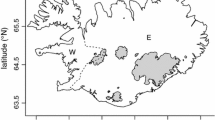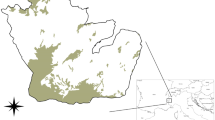Abstract
To select appropriate recovery strategies for endangered populations, we must understand the dynamics of small populations and distinguish between the possible causes that drive such populations to low numbers. It has been suggested that the pattern of population decline may be inversely density-dependent with population growth rates decreasing as populations become very small; however, empirical evidence of such accelerated declines at low densities is rare. Here we analyzed the pattern of decline of a threatened population of woodland caribou (Rangifer tarandus caribou) in British Columbia, Canada. Using information on the instantaneous rate of increase relative to caribou density in suitable winter foraging habitat, as well as on pregnancy rates and on causes and temporal distribution of mortalities from a sample of 349 radiocollared animals from 15 subpopulations, we tested 3 hypothesized causes of decline: (a) food regulation caused by loss of suitable winter foraging habitat, (b) predation-sensitive foraging caused by loss of suitable winter foraging habitat and (c) predation with caribou being secondary prey. Population sizes of caribou subpopulations ranged from <5 to >500 individuals. Our results showed that the rates of increase of these subpopulations varied from −0.1871 to 0.0496 with smaller subpopulations declining faster than larger subpopulations. Rates of increase were positively related to the density of caribou in suitable winter foraging habitat. Pregnancy rates averaged 92.4% ±2.24 and did not differ among subpopulations. In addition, we found predation to be the primary cause of mortality in 11 of 13 subpopulations with known causes of mortality and predation predominantly occurred during summer. These results are consistent with predictions that caribou subpopulations are declining as a consequence of increased predation. Recovery of these woodland caribou will thus require a multispecies perspective and an appreciation for the influence of inverse density dependence on population trajectories.





Similar content being viewed by others
References
Allee WC, Park O, Emerson AE, Part T, Schmidt KP (1949) Principles of animal ecology. Saunders, Philadelphia
Apps CD, McLellan BN, Kinley TA, Flaa JP (2001) Scale-dependent habitat selection by mountain caribou, Columbia Mountains, British Columbia. J Wildl Manage 65:65–77
Arditi R, Ginzburg LR (1989) Coupling in predator prey dynamics—ratio-dependence. J Theor Biol 139:311–326
Bartmann RM, White GC, Carpenter LH, Garrott RA (1987) Aerial mark-recapture estimates of confined mule deer in pinyon-juniper woodland. J Wildl Manage 51:41–46
Bergerud AT (1974) Decline of caribou in North America following settlement. J Wildl Manage 38:757–770
Bergerud AT (1996) Evolving perspectives on caribou population dynamics, have we got it right yet? Rangifer Spec Issue 9:95–116
Bergerud AT, Elliot JP (1986) Dynamics of caribou and wolves in northern British Columbia. Can J Zool 64:1515–1519
Bergerud AT, Page RE (1987) Displacement and dispersion of parturient caribou at calving as an antipredator tactic. Can J Zool 65:1597–1606
Bjørnstad ON, Grenfell BT (2001) Noisy clockwork: time-series analysis of population fluctuations in animals. Science 293:638–643
Caughley G (1976) Wildlife management and the dynamics of ungulate populations. In: Coaker TH (ed) Applied biology, vol 1. Academic, London, pp 183–246
Caughley G (1994) Directions in conservation biology. J Anim Ecol 63:214–244
Caughley G, Sinclair ARE (1994) Wildlife ecology and management. Blackwell Scientific, Oxford
Clutton-Brock TH, Gaynor D, Kansky R, MacColl ADC, McIlrath G, Chadwick P, Brotherton PNM, O’Riain JM, Manser M, Skinner JD (1998) Cost of cooperative behaviour in suricates (Suricata suricatta). Proc R Soc Lond B 265:185–190
COSEWIC (2002) COSEWIC assessment and update status report on the woodland caribou Rangifer tarandus caribou in Canada. Committee on the Status of Endangered Wildlife in Canada, Ottawa
Coulson T, Catchpole EA, Albon SD, Morgan BJT, Pemberton JM, Clutton-Brock TH, Crawley MJ, Grenfell BT (2001) Age, sex, density, winter weather, and population crashes in Soay sheep. Science 292:1528–1531
Courchamp F, Clutton-Brock T, Grenfell B (1999a) Inverse density-dependence and the Allee effect. Trends Ecol Evol 14:405–410
Courchamp F, Grenfell B, Clutton-Brock T (1999b) Population dynamics of obligate cooperators. Proc R Soc Lond B 266:557–563
Courchamp F, Clutton-Brock T, Grenfell B (2000) Multipack dynamics and the Allee effect in the African wild dog, Lyacon pictus. Anim Conserv 3:277–285
Dennis B (2002) Allee effects in stochastic populations. Oikos 96:389–401
ESRI (1996) Arc View GIS. Environmental Systems Research Institute Inc., Redlands
Fowler MS, Ruxton GD (2002) Population dynamic consequences of Allee effects. J Theor Biol 215:39–46
Gaillard J-M, Festa-Bianchet M, Yoccoz NG (1998) Population dynamics of large herbivores: variable recruitment with constant adult survival. Trends Ecol Evol 13:58–63
Gaillard J-M, Festa-Bianchet M, Yoccoz NG, Loison A, Toïgo C (2000) Temporal variation in fitness components and population dynamics of large herbivores. A Rev Ecol Syst 31:367–393
Hayes RD, Gunson JR (1995) Status and management of wolves in Canada. In: Carbyn LN, Fritts SH, Seip DR (eds) Ecology and conservation of wolves in a changing world. Canadian Circumpolar Institute, Occasional Publication No. 35, Edmonton, Alberta, pp 21–33
Hobson KA, McLellan BN, Woods JG (2000) Using stable carbon (delta C-13) and nitrogen (delta N-15) isotopes to infer trophic relationships among black and grizzly bears in the upper Columbia River basin, British Columbia. Can J Zool 78:1332–1339
Holt RD (1977) Predation, apparent competition and the structure of prey communities. Theor Popul Biol 12:197–229
Holt RD (1984) Spatial heterogeneity, indirect interactions, and the coexistence of prey species. Am Nat 124:377–406
Holt RD, Lawton JH (1994) The ecological consequences of shared natural enemies. A Rev Ecol Syst 25:495–520
Kuussaari M, Saccheri I, Camara M, Hanski I (1998) Allee effect and population dynamics in the Glanville fritillary butterfly. Oikos 82:384–392
Lande R, Engen S, Sæther B-E (1994) Optimal harvesting, economic discounting and extinction risk in fluctuating populations. Nature 372:88–90
Mduma SAR, Sinclair ARE, Hilborn R (1999) Food regulates the Serengeti wildebeest: a 40-year record. J Anim Ecol 68:1101–1122
Meidinger DV, Pojar J (1991) Ecosystems of British Columbia. British Columbia Ministry of Forests, Special Report Series 4, Victoria, British Columbia
Milner JM, Elston DA, Albon SD (1999) Estimating the contributions of population density and climatic fluctuations to interannual variation in survival of Soay sheep. J Anim Ecol 68:1235–1247
Morris DW (2002) Measuring the Allee effect: positive density dependence in small mammals. Ecology 83:14–20
Post E, Stenseth NC (1998) Large-scale climatic fluctuation and population dynamics of moose and white-tailed deer. J Anim Ecol 67:537–543
Rempel RS, Elkie PC, Rodgers AR, Gluck MJ (1997) Timber-management and natural-disturbance effects on moose habitat: landscape evaluation. J Wildl Manage 61:517–524
Resource Inventory Branch (1995) Relational data dictionary (RDD) 2.0. British Columbia Ministry of Forests, Victoria
Rettie WJ, Messier F (1998) Dynamics of woodland caribou populations at the southern limit of their range in Saskatchewan. Can J Zool 76:251–259
Roemer GW, Donlan CJ, Courchamp F (2002) Golden eagles, feral pigs, and insular carnivores: how exotic species turn native predators into prey. Proc Natl Acad Sci USA 99:791–796
Rominger EM, Oldemeyer JL (1989) Early-winter habitat of woodland caribou, Selkirk Mountains, British Columbia. J Wildl Manage 60:719–728
Rominger EM, Robins CT, Evans MA (1996) Winter foraging ecology of woodland caribou in northeastern Washington. J Wildl Manage 60:719–728
Ropstad E, Johansen O, King C, Dahl E, Albon SD, Langvatn RL, Irvine RJ, Halvorsen O, Sasser G (1999) Comparison of plasma progesterone, transrectal ultrasound and pregnancy specific proteins (PSPB) used for pregnancy diagnosis in reindeer. Act Vet Scand 40:151–162
Sæther B-E (1997) Environmental stochasticity and population dynamics of large herbivores: a search for mechanisms. Trends Ecol Evol 12:143–149
Sæther B-E, Ringsby TH, Roskaft E (1996) Life history variation, population processes and priorities in species conservation: towards a reunion of research paradigms. Oikos 77:217–226
Schaefer JA, Veitch AM, Harrington FH, Brown WK, Theberge JB, Luttich SN (1999) Demography of decline of the Red Wine Mountains caribou herd. J Wildl Manage 63:580–587
Seip DR (1992) Factors limiting woodland caribou populations and their interrelationships with wolves and moose in southeastern British Columbia. Can J Zool 70:1494–1503
Shackleton D (1999) Hoofed mammals of British Columbia. Royal British Columbia Museum and University of British Columbia Press, Vancouver
Shenk TM, White GC, Burnham KP (1998) Sampling-variance effects on detecting density dependence from temporal trends in natural populations. Ecol Monogr 68:445–463
Sibly RM, Hone J (2002) Population growth rates and its determinants: an overview. Phil Trans R Soc Lond B 357:1153–1170
Sinclair ARE (1989) Population regulation in animals. In: Cherrett JM (ed) Ecological concepts. Blackwell Scientific, Oxford, pp 197–241
Sinclair ARE (1991) Science and the practice of wildlife management. J Wildl Manage 55:767–773
Sinclair ARE, Arcese P (1995) Population consequences of predation-sensitive foraging: the Serengeti wildebeest. Ecology 76:882–891
Sinclair ARE, Krebs CJ (2002) Complex numerical responses to top-down and bottom-up processes in vertebrate populations. Phil Trans R Soc Lond B 357:1221–1231
Sinclair ARE, Pech RP, Dickman CR, Hik D, Mahon P, Newsome AE (1998) Predicting effects of predation on conservation of endangered prey. Conserv Biol 12:564–575
Spalding DJ (1990) The early history of moose (Alces alces): distribution and relative abundance in British Columbia. Contr. to Nat. Sci. #11. Royal B.C. Museum Victoria, British Columbia
Stephens PA, Sutherland WJ (1999) Consequences of the Allee effect for behaviour, ecology and conservation. Trends Ecol Evol 14:39–42
Stuart-Smith AK, Bradshaw CJA, Boutin S, Herbert DM, Rippin AB (1997) Woodland caribou relative to landscape patterns in northeastern Alberta. J Wildl Manage 61:622–633
Sutherland WJ (1996) Predicting the consequences of habitat loss for migratory populations. Proc R Soc Lond B 263:1325–1327
Sutherland WJ, Norris K (2002) Behavioural models of population growth rates: implications for conservation and prediction. Phil Trans R Soc Lond B 357:1273–1284
Systat Software Inc (2002) SYSTAT 10.2—Statistics I. Systat Software Inc., Richmond
Terry EL, McLellan BN, Watts GS (2000) Winter habitat ecology of mountain caribou in relation to forest management. J Appl Ecol 37:589–602
White GC (1996) Program NOREMARK software reference manual. Available online. http://www.cnr.colostate.edu/class_info/fw663/noremark.pdf. Cited 15 July 2004
Wittmer HU (2004) Mechanisms underlying the decline of mountain caribou (Rangifer tarandus caribou) in British Columbia. Ph.D. Dissertation, University of British Columbia
Zar JH (1999) Biostatistical analysis, 4th edn. Prentice Hall, Upper Saddle River
Acknowledgements
This project was funded by the British Columbia Ministries of Forests and Environment, Columbia Basin Fish and Wildlife Compensation Program, Parks Canada, Forest Renewal British Columbia, and numerous forestry companies that operate across the range of arboreal lichen feeding woodland caribou. H.U. Wittmer was supported by fellowships from the International Council for Canadian Studies, the University of British Columbia, and the Faculty of Agricultural Sciences at the University of British Columbia. We are thankful to the numerous people involved in data collection. C. Apps provided access to GIS basemaps and B. Lessard engaged in many stimulating discussions. P. Arcese, J. Brashares, F. Courchamp, M. Festa-Bianchet and D. Shackleton provided many helpful comments on earlier versions of this manuscript. Finally, we thank an anonymous reviewer whose comments greatly improved this manuscript.
Author information
Authors and Affiliations
Corresponding author
Additional information
Communicated by John Fryxell
Rights and permissions
About this article
Cite this article
Wittmer, H.U., Sinclair, A.R.E. & McLellan, B.N. The role of predation in the decline and extirpation of woodland caribou. Oecologia 144, 257–267 (2005). https://doi.org/10.1007/s00442-005-0055-y
Received:
Accepted:
Published:
Issue Date:
DOI: https://doi.org/10.1007/s00442-005-0055-y




